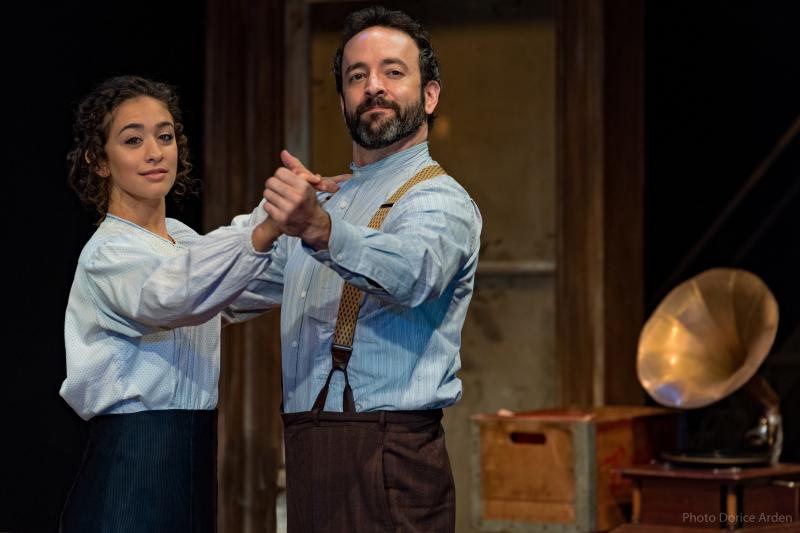“Director Thomas Caruso (associate director of the Broadway musical Groundhog Day) has delicately crafted a small world within the Little Room of the 6th floor walk-up. His hand-in-glove coordination with choreographer Ryan Kasprzak (a Chita Rivera Award nominee for Bandstand) and associate choreographer Kelly Liz Bolick is seamless, allowing the physical movement and proximity of the dance partners to color and inform Anna and Henry’s chemistry and relationship as the play progresses.”
In 1997, Andrew Horn, Penguin Rep’s Executive Director, commissioned Allan Knee to write a new work for Penguin. The play was called the “Man Who Was Peter Pan,” and it went on to become a film with Johnny Depp and subsequently the Broadway play “Finding Neverland.” Thus began the long and fruitful relationship between The Penguin Repertory Theatre and Mr. Knee.
.jpg)
A few short years later, Knee returned to Penguin with a vastly different kind of show, a play with dance and music. It was a hit at Penguin in 2003 and went on to win the American Theater Critics Award for Best Play. Set in New York in 1911-12, the play introduces us to a wonderfully mismatched pair of would-be ballroom dancers who are caught up in the ragtime craze that was sweeping the country.
A slightly anachronistic choice, the very first piece of music in the show is Lehar’s “Merry Widow Waltz” – a quintessentially Viennese song. While appropriate for the time (it was one of the most popular tunes in the world in the early part of the century) it features a lilting melody that’s just about the farthest thing imaginable from “syncopated.” Immediately following the waltz, however, the ragtime jazz bursts forth providing the heart, pulse and titular theme of the show.
Henry is a 38 year-old, Jewish butcher, who harbors passionate dreams of becoming a ballroom dancer, but cannot seem to secure a partner. He places numerous advertisements in the newspaper inviting women to “dance for royalty!” After weeks with no responses, Anna, a wistful, 24 year-old Italian seamstress from a local sequin factory, ascends the 108 steps to Henry’s 6th floor walk up “studio” (at nearly 22 steps per floor, those must be some high ceilings!)

From their first meeting, it’s clear that they are a poor match both as dance partners and as potential lovers, but not terribly unpredictably, that will soon change. At first, Anna is cannily cautious about Henry’s intentions and maintains a respectful distance. But his ebullient energy and sad-sack charm soon begin to win her over.
Josh Powell‘s Henry is an adorably awkward noodge, unartful in social graces but elegant and resourceful on the dancefloor. Mr. Powell brilliantly conveys Henry’s pent up passion and sense of longing that percolates just beneath the surface, as he equates success in the ballroom dance world with success and status in life. Mr. Powell’s physical performance is extraordinarily expressive and his facial expressions are simply priceless.
As their lessons progress, so does their relationship, deepening as their knowledge and understanding of one another grows, and an unforced and gentle intimacy emerges. However, Anna makes it abundantly clear that she is taken; engaged to a wealthy man whom she is very lucky to have landed. Still, Henry’s feelings for her become more and more evident as he asks her to come and practice more and more – first once a week, then twice, then finally three times a week and Saturday nights.
Ms. Annunziata’s Anna is at first brash and seemingly full of confidence (after all she does visit a strange man’s 6th floor apartment at night, unaccompanied, in 1911). But soon we see that she may be hiding behind a false bravado and the rosy future and prospect of marriage to a wealthy shop owner is more of a compromise than a dream come true. Ms. Annunziata was transcendent, her joyful smile lit up the entire theater – making her eventual disappointment all the more devastating. While Henry’s wants and needs are readily apparent from the first scene, it’s really Anna’s journey that provides the ups and downs of the play. Ms. Annunziata’s intensity and palpable vulnerability in Anna’s transformative moment was heartbreakingly beautiful.
Music and dance play an integral part in the evolution of the bond between Henry and Anna, as Mr. Knee deftly blends music, dance and dialogue into one expressive language. And through that language, we share Henry and Anna’s failed dreams, dashed hopes, but also their passion and joy. Their struggle is infectious and we can’t help rooting for them.
Director Thomas Caruso (associate director of the Broadway musical Groundhog Day) has delicately crafted a small world within the Little Room of the 6th floor walk-up. His hand-in-glove coordination with choreographer Ryan Kasprzak (a Chita Rivera Award nominee for Bandstand) and associate choreographer Kelly Liz Bolick is seamless, allowing the physical movement and proximity of the dance partners to color and inform Anna and Henry’s chemistry and relationship as the play progresses.
Special kudos must be extended to the extraordinary work of the technical staff of “Syncopation,” who have created a magically theatrical experience – superb work across the board. Michael Carnahan‘s sets and Lux Haac‘s costumes are picture perfect. The lighting design of Martin Vreeland and sound design of William Neal were nothing short of spectacular, beckoning the audience into Henry and Anna’s little world with a remarkably complex, yet delicate blanket of sound and color that drew you in and held you close.
It’s clear that Syncopation hasn’t lost a step since its initial production. It’s simply great theater.

.jpg)
